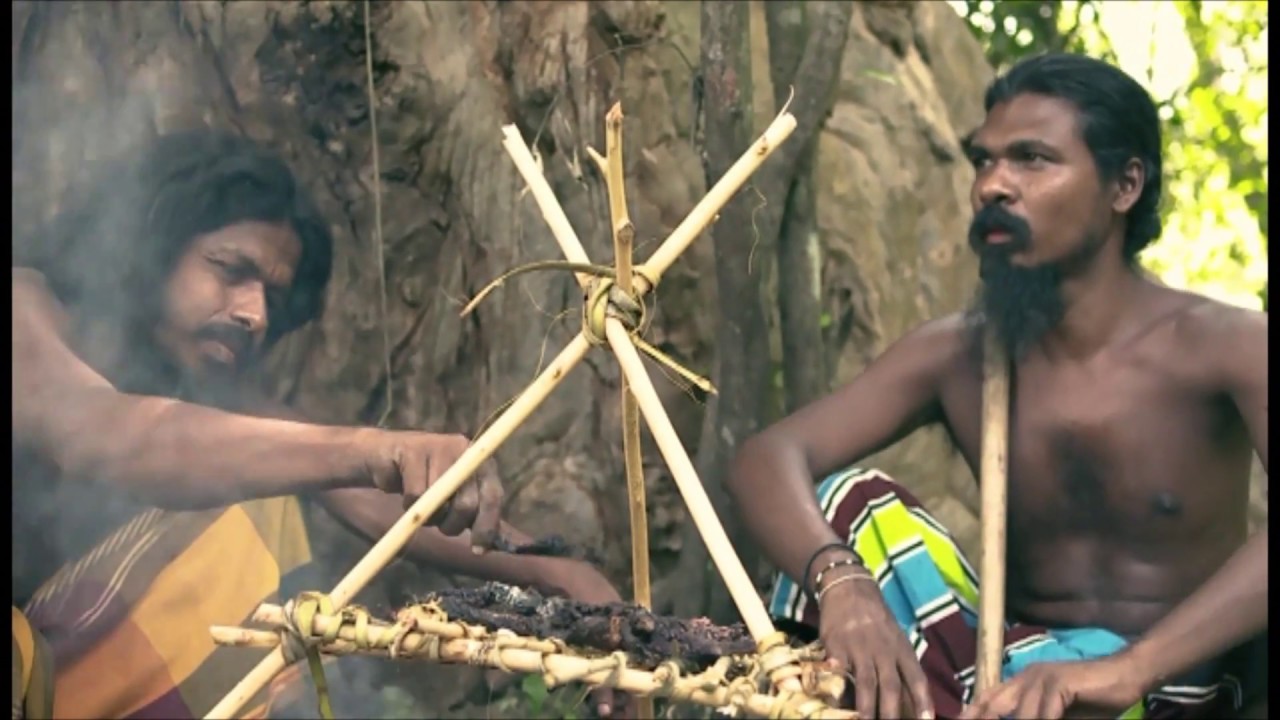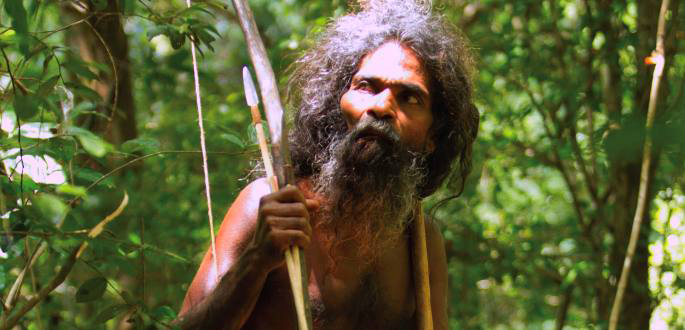Fishing (Diya Mechchi Allum Pojja Manda Karanwa)
BY Mr. Shakya Wijerathne

The Vedda or Wanniyalaeto, are a minority indigenous group of people in Sri Lanka
Within the indigenous community, male dominance can be clearly seen and females are involved in digging a rhizome, searching for greens and mushrooms.in the times of the living at jungles it can be assumed that females have produced a considerable contribution in fishing. At nonce fishing is solely proceeded by the males. The indigenous community of Dambana region is typically engaged in fishing centered on Ambagahathalawa wewa, Kandegamwila tank, Ulhitiya reservoir, Maduruoya reservoir, Kiriwanagalkandura Wewa, Kuda wewa, Weerindakote wewa, Demtanella ela, Kiwula Ella, Wadellalda Dehi aththa Oya, Puussuluwinna Oya, Maduru Oya Several specific fishing gears are deployed in the indigenous community such as introduction of toxins (Waha thaleema), Hitting with a sharpened weapon at nocturnal times in the areas with high abundance of fishes.; pressurizing fishes by feet in mud marshes. Piercing fishes with sharpened wooden darts and catching fishes by grabbing through underlying wooden branches in small water reservoirs. At nonce indigenous community has been inculcating fishing gears such as usage of several nets, usage of angling usage of “mandawa” usage of “karak gediya” usage of “wal kuda” ensnaring /setting of traps usage of several tubes People in the past have used various methods to meet their fish needs. The pots made by crushing the wild herbs together are mixed into the pits. To make the medicine, kukuru, daluk kiri tibiri etc. are used. Although this mixture has some effect on the fish, it does not harm the people who eat it. It is also used for fishing. Spikes made of iron and wood are used for special fishing. In addition, flashlights have been used at night to identify fishing grounds and to catch fish with any weapon. Though fishing using different methods in the past were adopted as above, currently several fishing gears are being adopted owing to the inadequacy of fish for consumption (net gear, etc.) Fishing is being done according to the population. Lula, Caucasus, and Magura were the most abundant fish in the canals and streams of the past. Telia, Kanaya, Ada, Hunga. These fish were the most targeted fish due to the species such as dandiya, angullo and path angullo. It is important to note here that the present aboriginal people (7-8 decades ago) did not have a correct understanding of the fish that were in the water while living in the forest. It is a summary that is relevant to the information of three or four generations.) Currently the most sought after fish in the area are the coralia, lula, caucasia, telia, catfish, rohu, tank salaya and angula.

Vedda people at Mahiyanganaya
In the past, everyone was involved in this work, but today it has become a limited task. Therefore, fishing people have a certain social status according to their behavior in the society. In the past he was able to fish as he pleased, but now he has to manage it according to some management. Namely, the reduction of fish due to large scale fishing due to past fish consumption, non-regular fishing, the establishment of fisheries societies to control the demand for small fish in the market, the appointment of officers as Fisheries Inspectors and various other matters. Deployment of officers of government institutions for this purpose can be seen. Those who go fishing as a group will share the fish they catch in equal parts and if there is a surplus fish harvest, those fish will be distributed to the rest of the village. Most of the time, the proceeds from the catch are now shared equally by the group. (A summary of the complete data collection.) In times of scarcity of fish, the most common occupation is farming. In the process of extracting honey and adding medicines. Although there were no legal issues in the past in fishing, various laws have been enacted today. Imposition of rules not to use nets which are more harmful to fish in fishing. Having a specific time set aside for daily fishing, going to the reservoirs, and returning. Prohibited fishing from lakes in protected areas. Laws such as the ban on small-scale fishing can be pointed out. (Complete data collection. Summary.) In almost all reservoirs, edible fish as well as inedible fish feed. Among the fish that are not caught by humans are Kanaya, Katupathiya, Welankola pathiya, Kawaiya, Weligowwa, Kanaya, Gal paduruwa

Vedda people at Mahiyanganaya
Among the fish varieties being consumed, there are some varieties which are not being consumed. Indigenous community bears sound knowledge to identify the species which are not suitable for consumption. As the fish species being subjected to consumption the followings can be clearly cited • ‘Coralie” • “Lula” • “Aada” • “Theliya” • “Magura” • “Kokassa” • “Hunga “ • “Dandi” • “Koduwawa” • Catla • Rohu • Kiri kanaya As per the preference for hunted meat Veddahs prefer consuming fish. Meanwhile some barriers can be identified in satisfying the need of fish consumption. Currently typical issues can be seen such as 1. High amount of expenses to be used to buy fishing gear equipment 2. Prohibition of fishing with in Maduru Oya Reserve 3. Drying of water reservoirs owing to drought conditions 4. Cultural barriers (fish consumption is banned during the times of preparing for “thovil”-traditional white magic’s) Focused on their knowledge on importance of fish consumption typical concepts stabilized in the indigenous community can be vividly identified. High fruitfulness of consuming fish for pregnant mothers and small children Newly born children will be beautiful when high amounts of fish are consumed by pregnant mothers Maintainance of oleaginous nature of joints Improvement Mara bone contents of joints through the consumption of fishes like “Aada”,” Lula”,”Theliya”,”Hunga” The communities who have made fishing as the modus vivendi are engaged in selling fish for the maintenance of the family. Some groups of people are engaged in fishing as a source of entertainment /recreational activity. On an occasion where an excess amount of fish harvest is received; it will be divided among the other social groups. Fishes that are captured deploying a certain fishing gear will be prepared to consume in different specific ways Cooking using salt, chilies and certain sour source Cooking using only salt and chilies Consuming with chilly and sour flavors after being baked in fire Preparing in gravy after being smoked Smoking on a wooden loft and consuming without salt and chilies. Consuming only with salt after being baked in fire Fishes are typically subjected to preservation using the following typical methodologies. Drying under fire Drying under sunlight after being soaked with salt Soaking in honey after being smoked Refrigeration (currently)* People who have lived an eco-friendly life have used various methods to preserve fish using their intellect. Drying in the smoke, drying in the sun. Traditional methods such as dipping in honey can be introduced. As people became stronger intellectually as well as financially, they became accustomed to using tools that could easily and efficiently accomplish that task. Use of refrigeration, use of the oven As well as the use of iron ovens to make barbecue method can be pointed out vividly Give a brief description of the process taken: Drying After being stored in a container, the container is opened and the fish is placed on a rocky plate and dried in the sun. Smoking - Catch the fish and clean the fish with a knife in the middle and wash it off with water. A fly is made of wood, and the fish is dried by putting a piece of wood under it, lighting a fire, and smoking it. Depositing in honey: - The flesh of smoked or sun-dried fish is stripped and placed in a clay pot or honeycomb filled with honey and kept covered to prevent wind. This is done to eat when needed. (A summary of the complete data collection.) There are many types of wood that can be used to preserve smoked fish. Mora, Kon, Vaa, Ehela, Seru, Palu and Weera woods are specially used for this purpose. These woods are used because they do not burn quickly and have the ability to dry fish as needed due to the longer the heat of the fire. Suggestions As per the suggestions made by the indigenous community the improve the level of fish consumption Increase the fish resource in remote tanks and reservoirs by introducing novel fishes Granting the permission to proceed fishing in the forest reserve Granting the permission to proceed fishing in reservoirs that are already banned Provision of fishing gear equipment free of charge or on a relief base Solving of issues related to the fishing community With the active mediation in solving the issues mentioned above with regard to the above suggestions, a tendency towards fish consumption can be increased which rhetorically enhances the level of fish consumption.
Objective of the project
Identify the fish consumption behavior, fisheries management, fish cooking and preservation techniques of Sri Lankan indigenous people.
Project members : Mr. Charitha Dias, Mr. Darshana Thilakarathne, Ms. Gayani Dias, Dr. Ravindra Deshappriya
Location : Mahiyanganaye, Sri Lanka
Duration : 6 months
Doners : Ms. Indika Wickramarathne, Mr. Charitha Dias & Mr. S. Shakya
Partners : Tourism Board, Badulla Regional Center

